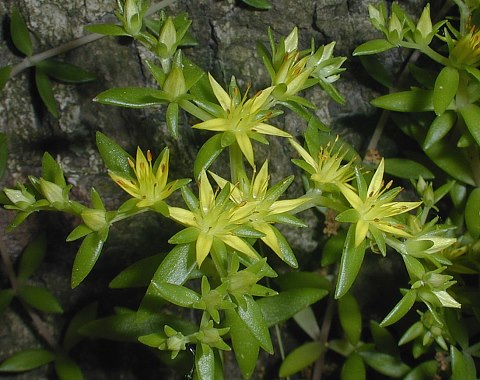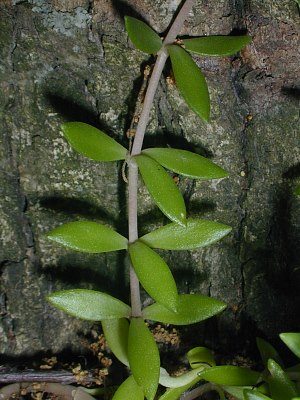Description: This herbaceous perennial plant has sprawling leafy stems up to 10" long and 6" high. The fleshy stems are light green to pale purple, glabrous or glaucous, and terete (round in cross-section). The fleshy leaves are arranged in whorls of 3 at intervals along the stem. Each fleshy leaf is up to 1" long and ¼" across, elliptic to narrowly lanceolate in shape, smooth along the margins, bright green and glabrous on the upper surface, flat, and sessile.

The upper stems
produce one-sided corymbs of flowers; each horizontal branch of the
corymb produces several upright flowers. Each flower is about ½"
across, consisting of 5 yellow petals, 5 fleshy green sepals, 10
stamens, and a cluster of 5 pistils. The petals are longer than the
sepals; they are both narrowly lanceolate to lanceolate. The blooming
period occurs from late spring into the summer and lasts about a month.
Each flower is replaced by 5 clustered follicles; each follicle is
pointed at the apex and contains several seeds. The root system is
fleshy and fibrous. This plant spreads by reseeding itself and by
forming vegetative offsets.
Cultivation:
Full sun to light shade, mesic to dry conditions, and a loamy or rocky
soil are preferred. Like other Sedum spp., this
stonecrop has a Crassula Acid Metabolism (CAM), which enables it to
withstand droughty weather.
Range & Habitat:
The introduced Whorled Stonecrop occasionally escapes from cultivation
and has
naturalized in several counties, particularly in the northeast region
of Illinois (see Distribution
Map). However, outside of flower gardens, it is still
uncommon. Habitats include open woodlands, vacant lots, roadsides, city
parks, and waste ground. Most Sedum spp. are
adapted to upland rocky areas, but this stonecrop has yet to escape
into this type of habitat. Whorled Stonecrop is native to Asia.

Faunal Associations:
Little is known about floral-faunal relationships for Sedum
spp., especially when they have been introduced from abroad.
Insects that feed on these plants include Aphis sedi
(Sedum Aphid) and Altica foliacea (Apple Flea
Beetle). According to Müller (1873/1883), the flowers of old-world Sedum
spp. are visited by various bees, wasps, Syrphid flies, and
Muscoid flies; these insects are attracted to the nectar or pollen. The
Eastern Chipmunk has been known to feed on the fleshy roots of a native
stonecrop (Sedum ternatum).
Photographic Location:
Underneath a tree at Crystal Lake Park in Urbana, Illinois, where it
may have been introduced by either a bird or a lawn mower.
Comments:
Whorled Stonecrop has beautiful flowers and foliage. This species is
readily distinguished from other yellow-flowered Sedum spp.
by its whorled leaves; it is more typical of a stonecrop to have
alternate leaves. Leaf shape and size is often important in making an
accurate identification. For example, the leaves of the commonly
cultivated Sedum acre (Biting Stonecrop) are more
short and terete than the leaves of Whorled Stonecrop.